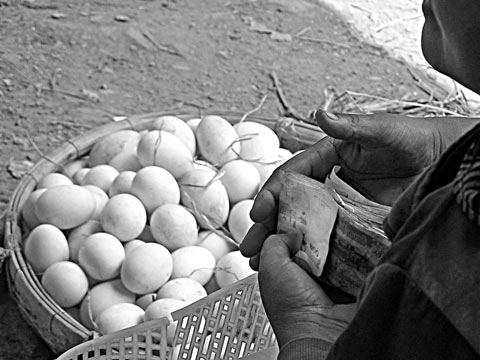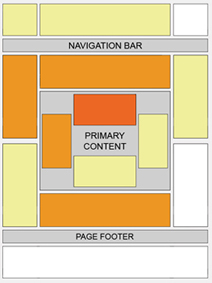
Selling eggs near Russian Market, Phnom Penh, Cambodia
I’ve been trying to update this post for about a year. My first attempt ended in me saying that you shouldn’t bother trying to make money from your food blog, or at least, you should not feel entitled to recompense for your creative endeavours.
It’s pretty hard to find a food blogger who makes a living from it who started food blogging after 2007. Google tends to favour those with a deep history. It’s also hard to find one who’s not in a partnership with somebody who makes or has made a decent income elsewhere. Any food blogger (or journalist for that matter) can look wealthy with the backing of a generous benefactor or understanding partner.
When I talk about making money, I mean making a living wage, not just a few dollars to pay for your web hosting or the occasional pint of bitter. You could do that by signing up for Google Adsense or Amazon Affiliates.
Most food blogs never plan to make any money, but if your goal is to make money online, the best thing for you to do would be to quit food blogging and start writing about something which is more lucrative and has less competition. When you blog about food for money, you compete with some of the world’s largest and best resourced media organisations for visitors. I’ve worked for a handful of these: a TV station, newspapers, magazines and a state tourism bureau. Most of them know what they’re doing online and while they have no monopoly on audiences for food, they do tend to have the lion’s share.
Bloggers can certainly pick over the carcase of the food media and occasionally hit some rich marrow but it is a very occasional and unpredictable feast.
While not the only source of income, the biggest problem for selling advertising with a blog now is scale. As the web keeps expanding so to does the potential advertising inventory, which makes advertising ever cheaper. From the blogger’s point of view, this means that there is incrementally more work that needs to be done to make the same amount of money over time from advertising. Bigger websites tend to win. They have the sales staff to work directly with media buyers; bigger audiences to segment; deeper inventories.
While in 2007, I might have recommended a handful of different ad networks or affiliate sites for your food blog, online food media has matured. If you want to work alone, it’s almost impossible to compete for a huge audience. At this point, I think that there are only two broad strategies to make a living by writing a food blog. They’re not mutually exclusive.
1. Going alone.
Get a job that you love in a related field.
No writer starts out as just a writer. Everyone has worked in the employ of others, attempting to do the work that enables a writing habit. The difference with blogging is that there is a variety of fields that contribute to being a better blogger. The direct path to this is somewhere in the web industry: writing editorial content for websites, and if you’re lucky enough, one that keeps you in touch with food.
There is no shortage of the types of roles that fit into the broader spectrum of jobs that train you to be a more rounded blogger: community management, analytics, search marketing, the digital side of public relations. There’s plenty which are almost impossible to break into, but where your blog is a calling card: food journalism, photography, styling.
This is how I make most of my living: variously, managing websites, social media, copywriting, SEO, analytics. At least over the last ten years, all of my work has contributed directly to the way that I write and much that I’ve learnt from writing a blog can be fed back into much larger websites. Often my blogs have become testing grounds for ideas that I’ve had for far larger projects. It’s a lot less costly to fail quickly on a blog than it is on a huge corporate budget.
Start a food business, not a blog.
I shouldn’t need to say this but the easiest way to make money is selling something. Blogging doesn’t do that directly but can act as a proof that you can build sorts of communities to whom you can sell. I’m in no position to tell you how to start your own food business and having worked in a few from farm gate to factory floor didn’t convince me that it was an altogether good idea.
Yet.
There are no shortage of bloggers tracing a path in this direction. Tammi Jonas (and family) started a free range rare breed pig farm, which is a complete extension of the food philosophy that she espouses on her blog. Jackie Middleton from Eating With Jack started EARL Canteen, serving some of the best luxury sandwiches in Melbourne. Aun Koh from Singapore’s Chubby Hubby started his own PR firm with a focus on food and lifestyle.
2. Going together.
You need a lot of people visiting a website that doesn’t sell anything to make an amount that approaches a living wage from affiliate sales and advertising. Not only do you need many people, but increasingly, those people need to be homogenous: same country, same demographic, same purchasing power. To some extent, this dictates the sort of blog that you’ll need to write. One that is mostly inoffensive and advertiser-friendly, low to middle brow, easy on the eye. A blog wherein you will know the exact demographic of the reader just by glancing at the design.
To get to an appropriate size, you need to publish more than your average food blogger. Plan for at least three posts a day, every day, forever. Unless you’re prepared to burn yourself out within a scant few years (or publish vast seas of utter shit), you can’t do this alone.
If you’re looking to make money from it, this starts to look much more like a business than a hobby. You’ll either need to convince other food writers and photographers to ditch what they’re doing and join you in partnership; work out some way of compensating others for their work; or take the Huffington Post model, where authors mostly work for “exposure“.
If you were to head down the path of starting a group blog:
- Write some objectives for the blog
- Why are you doing this?
- Work out how you’re going to compensate people. Or not.
- Write some editorial guidelines.
- Objectives for individual posts on the blog
- What is each post supposed to do? Is it to keep people reading and subscribing, or is it to make people click ads?
- Describe your audience: who do you want to read the blog? And are there enough of those people to be valuable to advertisers?
- Style guide: Is it a free for all, or are there minimum standards to adhere to? Images? Video?
- Write a linking policy: can authors link anywhere? Can they link back to their own writing elsewhere?
- Copyright terms: Can writers republish/resell what they’ve written? Who owns the work?
- Position on gifts/freebies. Can writers whore for swag?
These don’t need to be huge, especially if you’ve already got a good relationship with a small number of other contributors. One of my favourites is this gaming blog’s guide – they’re short and easy to understand. At a minimum, I’d include:
